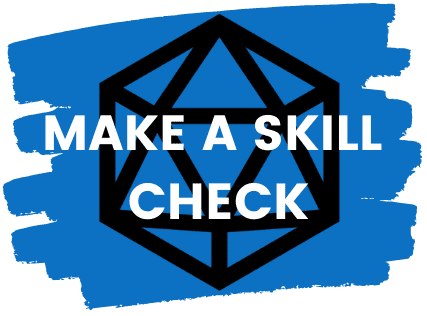It’s D&D night; The Player Characters (PCs) are all posing as regular patrons at the Silken Flower, waiting for a changeling who’s posing as the legendary singer Yllinka Dooru to appear. The pretender has managed to evade the party all week but can’t skip a performance. The PCs must catch them alive for interrogation, but they need to do it without killing any innocent bouncers or city guards nearby—All in a D&D session’s work. So how does nonlethal damage work?
To avoid killing in 5e, one can use magic, social skills, tactics, cunning, and nonlethal knockouts. There’s a rule for this in the Player’s Handbook (pg 198): when reducing someone to 0 hit points (HP) with a melee attack, you can choose to knock them unconscious—stable—instead of outright murder.
There is no such thing as non-lethal damage, only knockouts when bringing an enemy to 0 HP. Rules as written (RAW), you can even knock someone out with a melee spell attack, with which some people (including me) take issue. I don’t plan on allowing nonlethal Inflict Wounds at my table any time soon.

It’s also worth noting that the (non-optional) rule about instant death (PHB, pg 197) supersedes the one about knocking people out. Just a reminder of what that is:
When damage reduces you to 0 hit points and there is damage remaining, you die if the remaining damage equals or exceeds your hit point maximum.
PHB, pg 197
So no, you can’t bring a 20 (max) HP enemy to -30 in one slice and go, “but nonlethally!”
While not particularly sophisticated or immersive, the RAW knockout rule (PHB, pg 198) does help keep the ball rolling. That rule states:
When an attacker reduces a creature to 0 hit points with a melee attack, the attacker can knock the creature out. The attacker can make this choice the instant the damage is dealt. The creature falls unconscious and is stable.
PHB, pg 198
Still, we can explore the topic of nonlethal D&D 5e play further since one of the main complaints levied against the game is that it allegedly boils down to “kill shit, get loot” in most campaigns. Let’s dive in!
Table of Contents
Enabling Nonlethal Play in 5e
There are a few ways to make a campaign better suited for nonlethal play, which can be interesting from a storytelling standpoint and doesn’t necessarily equate to wanton do-goodery. A more robust system to deal with nonlethal conflict resolution doesn’t mean the campaign will necessarily punish killing, just that it affords other options.
A way to start is extending the death save privileges enjoyed by PCs and big-deal NPCs to everyone in the world. Be sure to make this clear in your session 0. This way, when the players want someone to stay down for good, they know to go the extra mile (Pathfinder has a Coup de Grace rule related to this); conversely, it also gives them some wiggle room to fireball an enemy group without necessarily killing off the high-priority target they need alive.
Enabling nonlethal play is also about providing opportunities to circumvent fights. Depending on the type of campaign you’re running, combat might simply be a fail-state that means the PC’s best-laid plans went awry. Potential combat can be stealthed/navigated/magicked around, defused with dialogue, and so on. Here are some other articles to help you out:
- 5e: Building Great Social Encounters
- 5e Stealth: Be As If You Were Never There
- D&D Exploration Pillar: How To Get It Right
On top of providing such opportunities, players must earn rewards for taking them just as they earn rewards for slaughter. We’re talking experience—level-ups if you do milestone—loot and direct effects on the story, which includes stuff like boons from their gods or the favor of particular factions (and enmity of whichever the opposing faction is).
Now, assuming fights will break out because it’s by and large what the game is about: not every fight’s goal is total obliteration of the other side.
Most things a D&D party fights are even more invested in their survival than the party’s demise. Humanoid foes will likely flee if things are going poorly; the party can choose to let them do it. Fights can also turn into negotiations. Taking this approach also makes relentless foes even scarier!
Finally, as a DM, you can give players tools (magical and otherwise) that amplify their nonlethal capabilities if that’s something they would like to pursue. Consider items to boost the party’s movement or social capabilities, wands that cast nonlethal spells, etc.
If you’re going to homebrew it, we have an article on that. Just always keep in mind the limits of these items and how they’re likely to be abused. It’s hard to take them away once given.
Looking to challenge your players?
Puzzles and Riddles can be tricky! Too easy and they’re pointless; Too hard and it’s pure frustration. What is a DM to do?
Well, our friends over at Dungeon Vault have an assortment of puzzles, riddles, and tokens to enhance your gaming experience. They even have a murder mystery and a political intrigue system!
For easy-to-use resources for any D&D game, check out the selections at Dungeon Vault!
Nonlethal Damage House Rules for 5e
First, the caveat: 5e is all about simplicity. It does away with simulationism and the crunch it requires. A more simulationist playstyle means a bit of extra crunch.
In 5e, a longsword deals 1d8 slashing damage when wielded with one hand; 1d10 when two-handed. Most DMs would likely allow it to deal piercing damage instead, depending on the attack’s description. Even bludgeoning if the player says, “I bonk the changeling with the flat/hilt of the blade!” or describes some crossguard half-swording action.
But would most DMs allow them to deal the weapon’s standard damage when using them in a way that goes counter to its core design? Bludgeoning is the damager type that makes the most sense for nonlethal incapacitation, so this is relevant to us now.
I wouldn’t allow a hit with the flat of the blade to deal the weapon’s regular damage, and I also think it’s not too complicated to tweak for immersion’s sake. Here are a couple alternatives that work based on the assumption the players must declare their attacks to be nonlethal before rolling:
- Using the longsword in such a way could be conceived as an improvised weapon attack, like hitting someone with a bow or throwing a mace. RAW, improvised weapons deal 1d4 damage unless some feature or feat says otherwise.
- The weapon damage-die goes down one size if it’s used to deliver a nonlethal blow. The example longsword would deal 1d6 bludgeoning damage instead of the usual d8 or d10.
- Likewise, a weapon meant to crush people with blunt force, like a warhammer, should also have its damage die reduced since a fully committed swing with it is lethal, too.
- Conversely, nonlethal takedowns don’t have to mean “humane finishers” (a word pairing I never expected to write). You can go the pain compliance way instead of knocking people out.
- Do you want to keep damage die size and be a bad motherf****r while nonlethally subduing someone? Shatter some kneecaps, pin people to walls through their shoulders, etc.
Another thing that is worth thinking about is what kind of weapon is particularly unfriendly to nonlethal KOs. Guns and flanged maces seem like clear cases of this to me (though there’s still the option of called shots in limbs or the aforementioned kneecaps).
And finally: Shocking Grasp functioning as a taser when bringing someone to 0 HP or less (save for instant death cases) makes sense; letting people deal nonlethal necrotic or fire damage doesn’t work that well. When applying the rule for knocking people out, spells invite a case-by-case approach.
Magic for Nonlethal 5e Play
Magic is a great way to deal with opposing forces nonlethally. Anything that immobilizes an opponent, or multiple opponents, long enough to properly restrain them is useful to avoid unnecessary bloodshed. The same goes for mind control effects, retreat facilitation magic, and a variety of debuffs. To quote a few classics:

- Banishment: send your enemy to another plane and keep them there as you prepare to run away, or hold actions to subdue them.
- Charm Person: Make the guard agree to be hogtied and gagged.
- Hideous Laughter: Crack a joke so funny that your opponent falls to the ground laughing for up to a minute.
- Hold Person: Make the guard stand still while someone hogties and gags him.
- Hypnotic Pattern and Stinking Cloud: temporarily incapacitate a whole bunch of people at once.
- Polymorph: easier to kidnap a slug than a resisting humanoid.
- Silence: Severely limit enemy spellcaster’s ability to resist the barbarian’s bearhug.
- Sleep: put a whole bunch of goblins to sleep at once, make the rest (if any) more likely to surrender. Note that this scales badly, but you could tweak it to allow for better use at higher levels.
This is far from exhaustive, but it gives a good idea of what I mean. Now you can comb through spell lists and pick your own spells to facilitate nonlethal play.
Summary
Let’s sum it up! This one’s short and sweet:

- There’s no “nonlethal” damage type.
- When reducing someone to 0 hit points (HP) with a melee attack, you can choose to knock them unconscious—stable—instead of doing a murder.
- RAW, this would allow any melee spell to be nonlethal, which strikes me as silly. Smart to consider each spell separately when thinking about how it interacts with this rule.
- To enable nonlethal play, you must provide opportunities for it and reward it. It’s not just about KOing people.
- Social encounters, exploration, stealth, magic trickery, etc., are all options for resolving conflict without killing.
- You can modify the KO rule to make it more immersive if you’re ok with a bit more crunch. I like having players declare that an attack is nonlethal before they roll damage.
- Consider applying improvised weapon rules to things like hitting someone with the flat of a blade.
- Magic is great for nonlethal play: mind control, restraining options, clever debuffs, polymorphing, and so on.







0 Comments